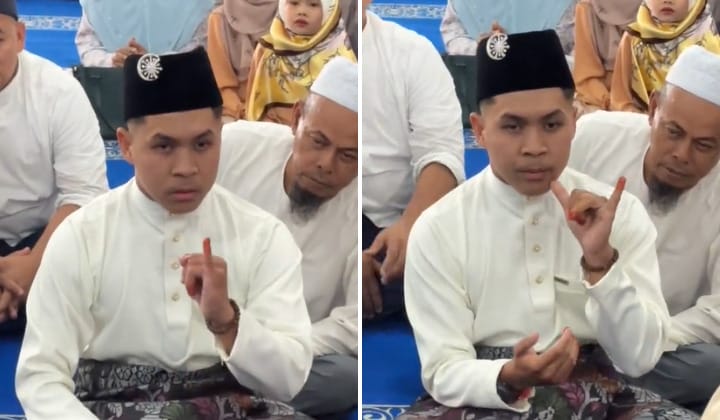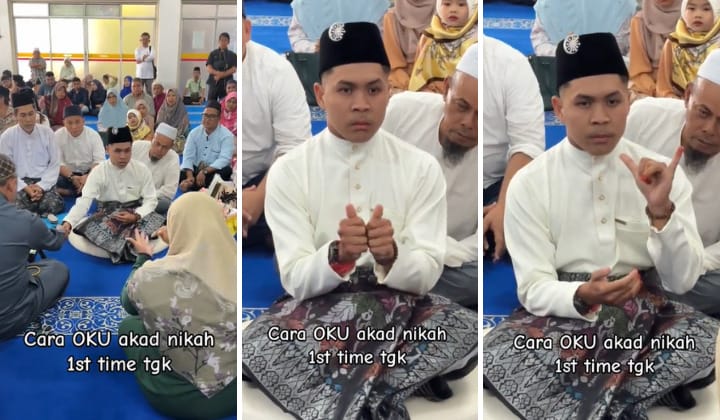Hearing Impaired Couple’s Wedding Ceremony Using Sign Language In Kelantan Warms Hearts
Both the bride and the groom are said to be hearing impaired.

Subscribe to our FREE Newsletter, or Telegram and WhatsApp channels for the latest stories and updates.
Weddings are a tearjerker, aren’t they? Especially the solemnization (akad nikah) part where the bride and groom become legally tied to each other as husband and wife.
Just witnessing a wedding of your close relatives is touching enough, now imagine witnessing a wedding of a disabled person, professing their love to each other.
Makes you believe in true love, doesn’t it?
Recently, a TikTok user (@abesolution9911), who’s also a wedding photographer posted a video of a special moment on 23 September when a hearing-disabled person (OKU) in Kelantan used sign language to profess his vow (akad nikah) to marry his bride. The TikTok user said that this is his first time seeing an OKU solemnization. The video garnered 5.6 M views and 534 K likes at the time of writing.

In the video, the groom was seen intently watching the translator (who was his mom) signing the words from the Wali (guardian of the bride) in the mosque. After the Wali declared his part, it was time for the groom to declare his. He slowly and nervously signed his part of the declaration while his mother translated it into words for everyone to hear with a mic.
As reported by Siakap Keli, because he was nervous (as any normal groom would feel at that moment), the groom had to do the akad nikah twice for it to be validated. And thankfully, the solemnization went well and smoothly.
@abesolution9911 Solute juruterjemaah dia berusaha utk Translate dr khutbah akad nikah smpai hbis
♬ Jiwa Yang Bersedih (Sped Up Version) – Ghea Indrawari
Netizens were touched
The video warms the hearts of many, and many people chimed in the comment section to express their reactions.
According to a commenter who seemed to know the couple personally and was at the wedding, he said that both the groom and the bride are hearing-impaired persons with disability. This makes it extra special.

Some couldn’t help but shed tears of joy watching the video.
Most admitted that this was their first time seeing a solemnization ceremony involving a hearing-impaired couple. Many congratulated the lucky couple, Hakim and Nuyu, and wished them a long and happy marriage.





Others also commented on how funny the groom’s reaction was after he successfully signed his vow. They find his unintentional side-eye to the Tok Kadi funny as he might be nervous at the time, anxiously waiting for the Tok Kadi’s approval.




OKU statistics
Because of the rarity of the occurrence, it is really a spectacle to see a heartfelt wedding solemnization like this, isn’t it?
According to the Department of Welfare (registration is not mandatory), the registered OKU population in Malaysia is 1.9% (637,537) as of 31 January 2023.
Over 1.5 billion people in the world or 5% of the global population suffer from hearing loss, as reported by the World Health Organization (WHO). In 2019, statistics revealed that over 1.9 million people in Malaysia are hearing-impaired.
Degrees of Hearing Loss
For your information, people who have hearing loss or the term “Hard of Hearing” are only able to hear some of the speech and sounds around them. People who can hardly hear anything or can’t hear anything at all are considered “Deaf”.
To give you a clear picture, a person’s breathing is around 10 decibels (dB), a whisper is between 20 – 30 dB, a normal conversation is around 40 – 60 dB, a scream or a movie theatre is 70 – 125 dB, a rock concert is 120 dB and a firework or gunshot is 140 – 160 dB.
So hearing loss is categorised into five different degrees, ranging from slightly impaired to profound ones. The category includes:
- Slight – cannot hear sounds below 15 to 20 dB
- Mild – cannot hear sounds below 26 to 40 dB
- Moderate – cannot hear sounds below 40 to 69 dB
- Severe – cannot hear sounds below 70 to 94 dB
- Profound (deaf) – cannot hear sounds lower than 95 dB
“Deaf” individuals mostly have profound hearing loss, which means very little or no hearing. They usually use sign language for communication.
Alternatively, they may use assistive listening devices (hearing aid, cochlear implants), read lips, or captioning to understand speech by others.

Share your thoughts with us via TRP’s Facebook, Twitter, Instagram, or Threads.

